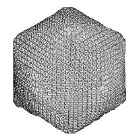Plant Pathology, Department of

James Van Etten Publications
Document Type
Article
Date of this Version
2011
Citation
American Scientist 99:4 (July-August 2011), pp. 304-311.
Abstract
The common view of viruses, mostly true, is of tiny burglars that sneak into cells, grab the biosynthetic controls and compel the cell to make huge numbers of progeny that break out of the cell and keep the replication cycle going. Viruses are supposed to be diminutive even compared to cells that are just a micrometer (1,000 nanometers) in diameter. They are supposed to travel light, making do with just a few well-adapted genes.
In 1992, a new microorganism was isolated from a power-plant cooling tower in Bradford, England, where Timothy Robotham, a microbiologist at Leeds Public Health Laboratory, was seeking the causative agent of a local pneumonia outbreak. His search led to the warm waters of the cooling tower, a known reservoir for bacterial pathogens in the Legionella genus, which are the cause of the pneumonialike Legionnaire’s disease. Particles present in the sample were mistakenly identified as bacteria. Gram positive and visible under the microscope as pathogens within the particle-gobbling amoeba Acanthamoeba polyphaga, the entities surprisingly did not generate any product from the gene-amplifying polymerase chain reaction technique using universal bacterial primers.


Comments
© 2015 Sigma Xi, The Scientific Research Society. Used by permission.